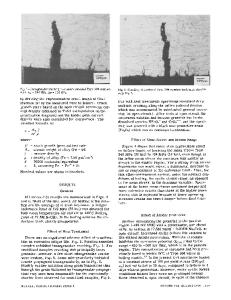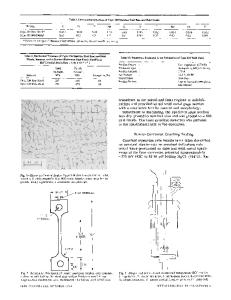Electrochemical evaluation of a corrosion fatigue failure mechanism in a duplex stainless steel
- PDF / 501,459 Bytes
- 11 Pages / 612 x 786 pts Page_size
- 73 Downloads / 345 Views
7/10/04
15:26
Page 2427
Electrochemical Evaluation of a Corrosion Fatigue Failure Mechanism in a Duplex Stainless Steel M.R. STOUDT and R.E. RICKER Laboratory corrosion fatigue studies on smooth and precracked samples indicated that two duplex stainless steels would have similar service lives in a paper-processing environment; but, in service, one of these alloys has exhibited premature failures. Since corrosion fatigue experiments had proven unable to detect this failure mechanism, electrochemical measurements and slow strain rate tensile tests were used to evaluate four alloy composition-dependent failure mechanism hypotheses. No significant differences were found in the dissolution rates or hydrogen fugacities produced when mechanical processes expose bare surface, and slow strain rate tensile tests found no indication of a difference in cracking susceptibility for the same hydrogen fugacity. Electrochemical experiments found that pits nucleate in one phase of the duplex microstructure at lower potentials in the failure prone alloy, but do not propagate beyond the microscopic dimensions of this phase. These microstructurally limited “micropits” were found to nucleate fracture in slow strain rate tensile tests, and examination of a service failure confirmed the presence of microscopic pits at crack initiation sites. The premature failures are attributed to the lower pitting resistance of the failure prone alloy, and the failure of laboratory experiments to predict this behavior is attributed to the slow kinetics of pit nucleation in these experiments. A laboratory testing methodology is suggested that will ensure detection of similar susceptibilities in future corrosion fatigue testing programs.
I. INTRODUCTION
THE final stages of the paper-making process involve the separation of the processing solutions from the pulp slurry through the use of a series of cylindrical suction roll shells. These rolls are large hollow cast stainless steel cylinders about 1.0 m in diameter and up to 8.0-m long with wall thickness ranging from 50 to 100 mm. These tubes are perforated by a multitude of radial holes and moderate vacuums are employed to facilitate extraction of the processing solutions, as shown schematically in Figure 1.[1,2] A typical suction roll shell may experience more than 109 load cycles during a single year of operation, and the service lives of these rolls range between 5 and 8 years.[1] The combination of the rotational frequencies, cyclic stresses, and constant contact with highly aerated process solutions generates an aggressive service environment for these components. Hence, failure of these components has been a long-standing problem in this industry.[1,2,3] The pulp and paper industry has conducted extensive laboratory-scale investigations into the corrosion fatigue behavior of alloys designed for this application using both tests on initially smooth samples (SN tests) and crack propagation experiments using precracked samples (da/dN tests). However, discrepancies still exist between laboratory me
Data Loading...











